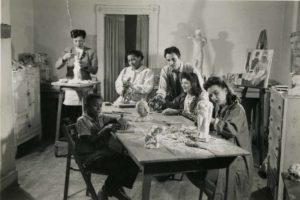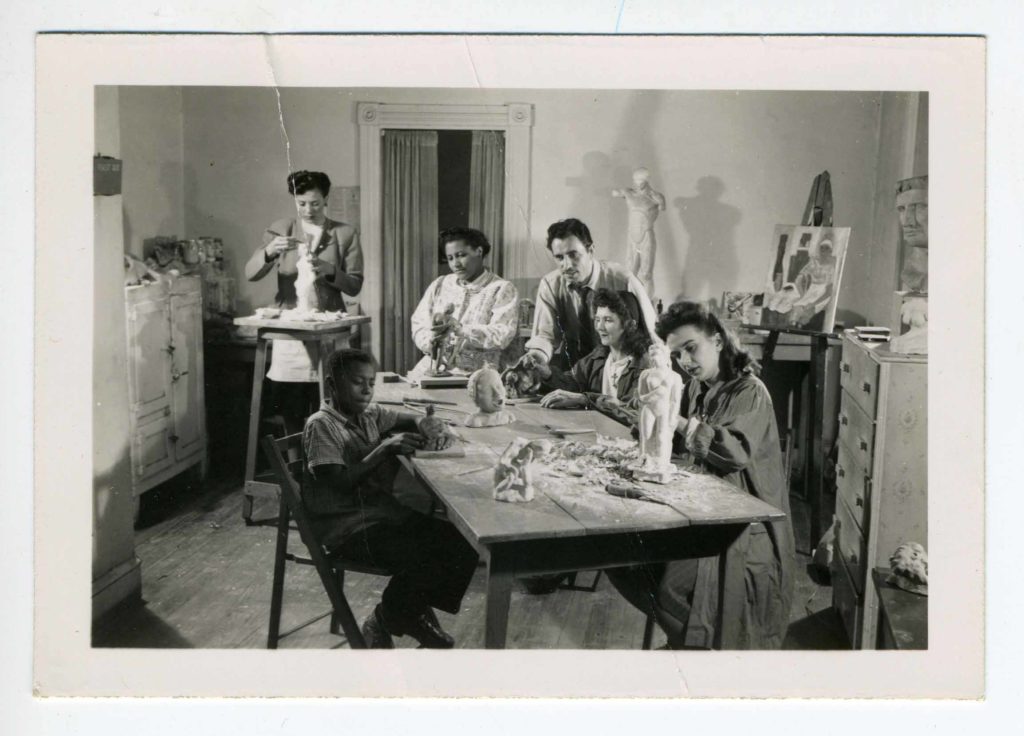A Trip to Fellowship House

Blog post by JMM Archivist Maggie Hoffman. To read more posts from Maggie, click here.
Last week’s #ArchivesHashtagParty, a social media initiative hosted by the U.S. National Archives, focused on #ArchivesBlackEducation in honor of Black History Month. When digging for content, a conversation with Joanna Church, JMM Director of Collections and Exhibits, led me to the Baltimore Art Center (BAC), a project of the Baltimore Interracial Fellowship. I highlighted the history of the BAC in a few tweets, but there are layers to history and tweets are awfully short. One layer of this story—the one I’ll share here today—begins with Reuben Kramer.
Reuben Kramer, whose family immigrated to Maryland from Russia, was born in East Baltimore in 1909 to Bessie and Israel Kramer. The youngest of six, Kramer noted in a 1934 interview that he always aimed to become a sculptor. Though Israel desperately wanted his son to study law or medicine, Reuben Kramer was an artist through and through.
At age 15, Kramer was granted a scholarship to night school at the Maryland Institute College of Art (MICA). He went on to study sculpture at MICA’s Rinehart School of Sculpture where he was the youngest student ever admitted to the program. While at Rinehart, Kramer met Perna Krick, a classmate who he would later marry. He went on to study in Europe on scholarship, and at the young age of 24, Kramer’s sculpture “Dying Centaur” won the Prix de Rome, a prestigious award that funded two years of study at the American Academy in Rome.
In addition to his artistic vision and skill, Kramer found value in guiding students. In 1944, Kramer founded the Baltimore Arts Center, a project of the Baltimore Interracial Fellowship, known colloquially as Fellowship House. Located at 21 Preston street, Fellowship House was
“[A] laboratory in human relations, which concentrates on the cultural, educational, and religious aspects of life…[where] hundreds of Americans of many racial and religious backgrounds, who come from every section of the city and suburbs [learned] how to solve the nation’s Number One problem: ‘How can the people of the world get along together?’”
The organization, founded in 1938, offered Baltimoreans a wealth of program resources, including youth programming, theatre productions, a speakers bureau, a fellowship choir, and even an intercultural doll library. The Baltimore Arts Center, which evolved out of the Baltimore Interracial Fellowship in 1944, was praised for its esteemed faculty and dedicated students, but it was significantly under-resourced compared to neighboring MICA.
Aside from funding, there was another clear distinction between the two institutions. The Baltimore Arts Center was a space for people to study sculpture and other art forms regardless of race. MICA, on the other hand, had long been explicit in its ‘Rules and Regulations’ which, in the school’s 1936 handbook stated that “reputable white pupils only are admitted to the Schools.”

In 1946, a multi-page profile on the Baltimore Art Center written by Paul Yaffe, an art lecturer at the BAC and a teacher in Baltimore Public Schools, was published by The Movement Magazine, a monthly publication that highlighted local businesses and initiatives of interest to Black Marylanders. Written only two years into the BAC’s existence, the article decreed the initiative a resounding success, explaining “It was evident that a need existed for thorough instruction in Art which would be available . . . to Negroes as well as to Whites. The challenge was as plain as the big need, and the staff of the Art Center rose to meet it.”
In 1947, Leon Norris, a Black artist and veteran, attempted to apply to the Maryland Institute College of Art but was barred from admission because of his race. Norris filed a suit against the mayor and city council of Baltimore, requesting entry to the institution or a commitment from the city to cease funding MICA. Amidst his legal battle, Norris was admitted to the Baltimore Art Center, where Reuben Kramer was serving as the organization’s director and teaching sculpture. According to a 1947 article from The Evening Sun, fifteen of the BAC’s seventeen students were Black.
Nearly a year after filing his suit, Leon Norris lost the case in full. MICA wouldn’t integrate until 1954 in a policy decision prompted by Brown v. Board, a case successfully argued by Maryland’s own Thurgood Marshall.
In 2019, archivist and artist Deyane Moses designed Blackives, an exhibit that highlighted MICA’s racist past. Moses also organized a demonstration, Take Back the Steps, that honored the generations of Black artists who had been unjustly denied admittance to the institution, including Leon Norris. Moses’ activism prompted an official apology by the current MICA president, Samuel Hoi, for the institution’s legacy of racism and discrimination against Black artists.
As noted earlier, this story is just one layer of the Baltimore Art Center’s rich history. To understand the organization’s history in full, we’ll need to explore other threads together. I can’t wait to return to Fellowship House with you another day!
Thank you to Deyane Moses and the Maryland Institute Black Archives (MIBA) for collecting and preserving evidence of this history.
The JMM is privileged to hold a small collection of Reuben Kramer’s materials, including art, artifacts, and archival material.
The bulk of Reuben Kramer’s papers are held by the Enoch Pratt Free Library Special Collections.
